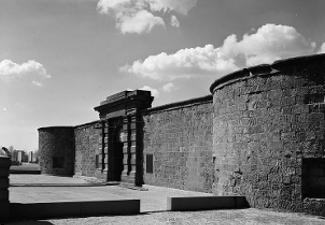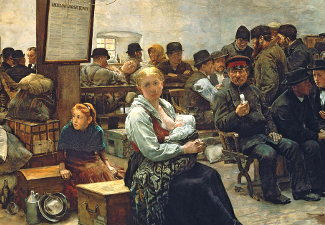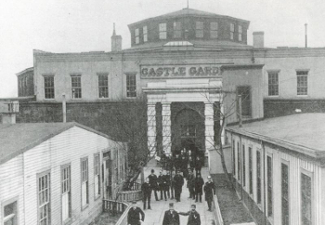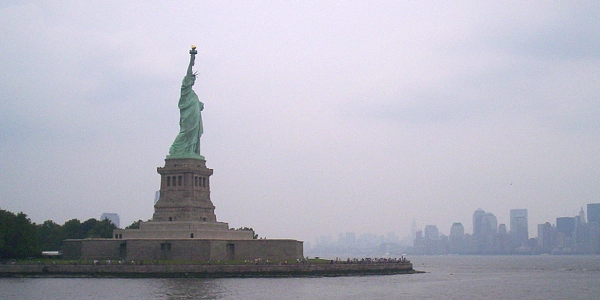
Above photo: Historic American Buildings Survey photo of the entrance to Castle Clinton. Photo courtesy Library of Congress. Right: Lithograph of Castle Garden during the immigration years. Source: National Park Service.

Castle Clinton National Monument
For such a small package, it packs a history wallop. Castle Clinton was the original immigration center for New York City, prior to Ellis Island in the center of the harbor. It was a fort, protecting Manhattan from the British in the War of 1812. It hosted some of the most entertaining ladies of the Victorian day in songstress Jenny Lind, as well as an aquarium. This castle and subsequent additions and subtractions on the same footprint has occupied this singular acre in Battery Park on the end of Manhattan, drawing visitors from abroad who wanted a life in the United States, and visitors from within, who wanted to witness the many pursuits available. And even though its history tends to take a back seat to the statue and immigration story in New York Harbor, it really does not take a back seat to anyone, or anywhere, in the stories that were told within its walls and how they grew the city and the nation.
Click here to Sponsor the page and how to reserve your ad.

Castle Clinton Then
Southwest Battery - For three years prior to the War of 1812, the sandstone fort was built on an artificial island in the harbor. Subsequent landfill would attach it to the shore. The fort housed twenty-eight cannons and was in Army use until 1821. It never saw action.
Castle Garden Entertainment - On July 3, 1824, the complex, originally open air and later roofed, opened with exhibitions and concerts. These lasted through 1854.
Castle Garden Immigration Center - On August 1, 1855, Castle Garden opened as the first official immigration center in the nation. operated by the state until April 18, 1890, then replaced by Ellis Island in 1892. Eight million immigrants were processed through Castle Garden; two of every three in that time period.
New York City Aquarium - Opened on December 10, 1896 to thirty thousand visitors within a rebuilt Castle Gardens complex, the aquarium remained there until 1941. It was the city's most popular attraction, attracting at average of five thousand people per day.
Timeline of Castle Clinton/Castle Garden
1808 - Construction of the Southwest Battery begins.
1823 - Fort deeded to New York City.
1824 - Restaurant and theatre opened on site known as Castle Garden.
1850 - Swedish singer Jenny Lind made debut there.
1855 - Opened as main immigrant depot for the United States.
1896 - Building remodeled as the New York City Aquarium.
1957 - Aquarium moved to Coney Island after it had closed at Castle Garden in 1941.
1975 - Opened as Castle Clinton National Monument.
Photo above: Castle Garden in its theatre days, 1850. Courtesy National Park Service/Library of Congress. Below: Current photo of the walls at Castle Clinton. Source: National Park Service.

Castle Clinton Now
Saved from Demolition - Robert Moses, the powerful Parks commissioner for the city, swelled with confidence after the successful New York World's Fair of 1939-40 held in Flushing Meadows, wanted to tear down Castle Gardens and build a bridge from the end of Manhattan to Brooklyn. The public hated the idea. Eventually, the Federal Government thwarted it, with President Roosevelt claiming that bombing the bridge, if built, would block access to the East River and the Brooklyn Navy Yard. On August 12, 1946, Castle Garden was deemed a national monument. On August 28, 1949, the U.S. Senate allocated $116,750 to restore it to its original appearance.
Castle Clinton reopened on May 24, 1975 after thirty years, with a concert, Beethoven's 9th Symphony, set in the same location as its 1846 debut. The complete renovation cost $750,000 and the site opened for daily visits on June 20.
Today, you can visit the restored castle and hear the stories of its various eras in a guided walk, or just marvel at the view from its edge on a park bench. You can also jump on a ferry and check out the more famous Statue of Liberty and Ellis Island from here, but that's a tale for later. Castle Clinton has a prior and even broader story to tell. With tensions increasing between the United States and Britain in the early 1800's, northwest U.S. cities began to build fortifications. New York built four; Castle Williams on Governor's Island, Ford Wood on Bedloe's Island (Liberty Island), Fort Gibson on Ellis Island, and the Southwest Battery (name changed to Castle Clinton several years later) on Manhattan Island. The forts were never used in the War of 1812. And that's just the beginning.
Photo above: Current photo of the walls at Castle Clinton. Source: National Park Service.
T-Shirts and Souvenirs

Castle Clinton National Monument T-Shirts and Souvenirs. Official gifts from Americabesthistory.com provided at Teepossible.

Castle Clinton
Things You Should Not Miss
1. Take the Castle Garden tour. It's the best way to learn about the variety of uses this small area has had over the last two hundred years. You'll find out about its years as a fort, immigration center, entertainment venue, and aquarium, all from park rangers who know their New York history.
2. Take in a special program. This site in Battery Park is known for concerts. Not a whole lot better evening spent than on the waterfront listening to music.
3. Okay, take a walking tour of the park, fort, and exhibits, then head out to the Statue of Liberty and Ellis Island. You'll get the whole breadth of how immigrants made their way into the northeast United States all in one day, but spanning over one hundred years.
Photo above: Old Castle Garden as an Aquarium, circa 1900. Source: Library of Congress.

Get Baseball History and Books at Stat Geek Baseball, including Stat Geek Baseball, the Best Ever Book.
Visitor FAQ
Castle Clinton Links
Castle Clinton National Monument
Official Guide New York City
New York Harbor Parks




